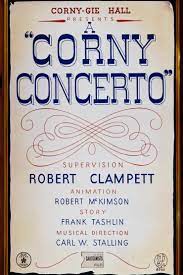
| Genres | |
| Runtime | 8 |
| Age | 3+ |
| Director | Robert Clampett |
| Rating | 94% () |
Animation Techniques Used
Have you ever seen a still photograph that looks like its moving? Thats what a cinemagraph is, and it gives the film A Corny Concerto (1943) a unique visual style. But what is it about these cinemagraphs that make them so special? Well, their ability to blend still images with motion provides a sense of realism to the film that cant be achieved with traditional animation techniques. With these cinemagraphs, the viewer can almost feel like they are in the middle of the action, as the characters move and interact with the environment. Its a creative way to bring the film to life.
Cutouts: Cutout animation was used to create the various characters and backgrounds of the film.
Cutout animation has been a staple of the animation industry since its inception, and A Corny Concerto is no exception. You may ask, what is cutout animation? Well, cutout animation is a technique of animation where cutout pieces of paper, photographs, or drawings are moved around, frame by frame, to create a significant motion. In A Corny Concerto, this technique was used to create the various characters and backgrounds of the film. The amount of detail and the level of artistry that the creators achieved with this method is truly remarkable. Its why this film has stood the test of time, and why it remains a beloved classic.
Stop-Motion: Stop-motion was used to animate various objects such as the singing canary and the cobblers dozen of corn.
Have you ever watched a movie and wondered how it was made? Well, in the 1943 movie A Corny Concerto, stop-motion was used to animate various objects such as the singing canary and the cobblers dozen of corn.
But what is stop-motion?
Stop-motion is a technique where objects are moved in small increments between individually photographed frames, creating the illusion of movement when the images are played in sequence. This technique was used to bring the singing canary and cobblers dozen of corn to life in A Corny Concerto.
Its incredible to think that with stop-motion, such simple objects can be transformed into something so lifelike and entertaining!
Multiplane Camera: The multiplane camera was used to create a 3-dimensional effect in the scene transitions.
Have you ever wondered how the filmmakers of A Corny Concerto (1943) achieved such a unique and impressive 3-dimensional effect in the transitions between scenes? Well, they used a revolutionary technique known as the multiplane camera. This camera allowed them to capture each scene from multiple perspectives, creating a realism and depth that was never seen before in animation. It was an incredibly complex piece of machinery and took weeks to set up properly. But, the results were worth it. The multiplane camera truly revolutionized animation and enabled filmmakers to create stunning visuals that were never seen before.
I enjoyed A Corny Concerto because it was a fun and lighthearted cartoon that made me laugh
I recommend A Corny Concerto for anyone who loves classic cartoons or anyone who enjoys classic music
I like A Corny Concerto movie because it is a classic cartoon short film that has a lot of humor and a great story
A Corny Concerto is unique due to its incorporation of more comedic elements in comparison to classical music
A Corny Concerto is fantastic movie for the reason that it is full of comedy and music